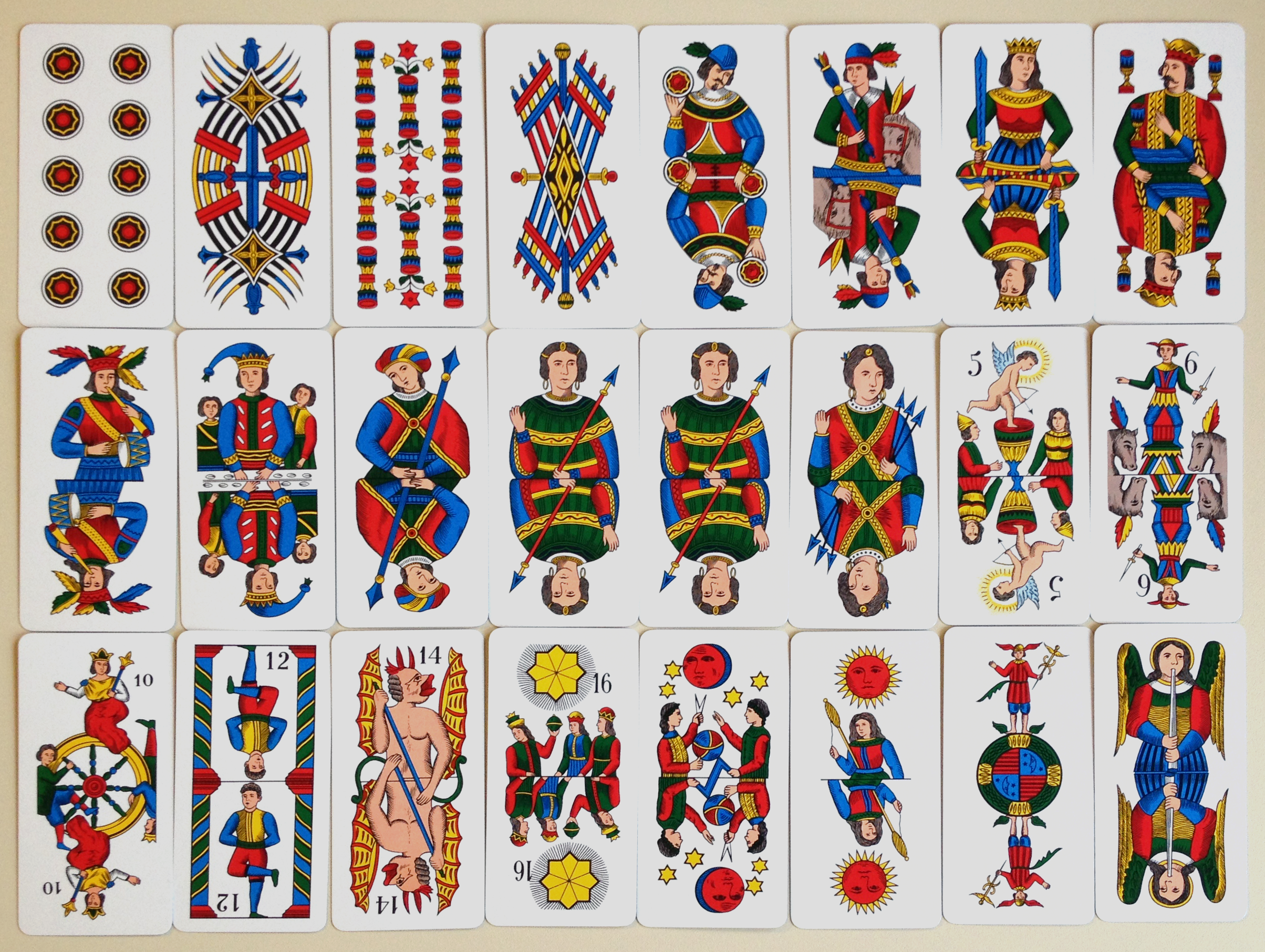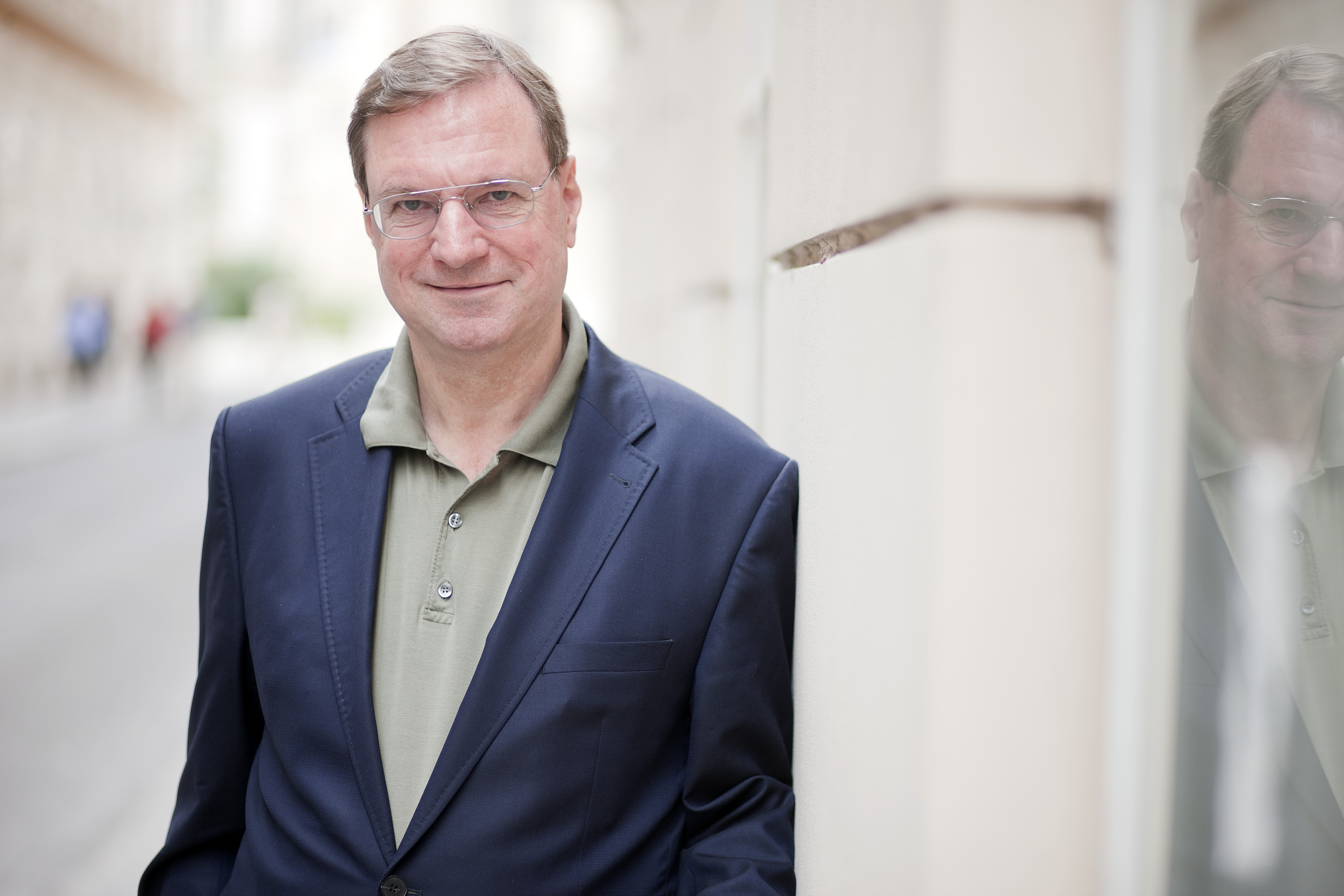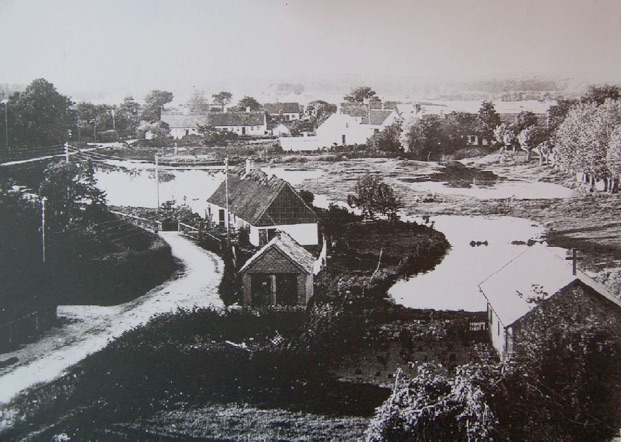|
Grosstarock
Grosstarock (german: Großtarock) is an old three-handed card game of the Tarock family played with a full 78-card Tarot pack. It was probably introduced into the southern German states around 1720 but spread rapidly into Austria and northwards as far as the Netherlands and Scandinavia. It only survives today in Denmark where it is called Tarok. Classical Grosstarock is not related to the modern 54-card game known as Viennese Grosstarock which developed out of Zwanzigerrufen. History This form of Tarot game was introduced into Germany from France around 1720, its initial terminology and mode of play being typically French. The original game - which may be referred to as classical Taroc (''Tarocspiel'' or ''Taroc-Spiel'') - was a simple, three-hander with no bidding but several card combinations, as can be seen from descriptions in the 1750s. However, it differed from its French predecessor in having significantly fewer declarations; in addition, the Fool had to be played befor ... [...More Info...] [...Related Items...] OR: [Wikipedia] [Google] [Baidu] |
Viennese Grosstarock
Viennese Grosstarock is a modern, three-player Austrian card game of the Tarock family that emerged in Vienna during the 1950s and 1960s. The game died out in the 1970s, but was revived in 2004 and further developed. Description Viennese Grosstarock is a Tarock card game for three-players played with a 54-card Tarock pack. The name, which means 'big tarock', refers to the size of the pack which was larger than the 40-card pack used for the more common game of Zwanzigerrufen. In the same way, the name 'Grosstarock Grosstarock (german: Großtarock) is an old three-handed card game of the Tarock family played with a full 78-card Tarot pack. It was probably introduced into the southern German states around 1720 but spread rapidly into Austria and northwards a ...' was used in the 19th-century to refer to the original 78-card game at a time when the 54-card game was introduced and spreading throughout Austria and into Germany. However, the two games are not directly related. Unique ... [...More Info...] [...Related Items...] OR: [Wikipedia] [Google] [Baidu] |
Tarock
Tarot games are card games played with tarot decks, that is, decks with numbered permanent trumps parallel to the suit cards. The games and decks which English-speakers call by the French name Tarot are called Tarocchi in the original Italian, Tarock in German and various similar words in other languages. The basic rules first appeared in the manuscript of Martiano da Tortona, written before 1425. The games are known in many variations, mostly cultural and regional. Tarot games originated in Italy, and spread to most parts of Europe, notable exceptions being the British Isles, the Iberian peninsula, and the Balkans.David Parlett, ''Oxford Dictionary of Card Games'', pg. 300 Oxford University Press (1996) They are played with decks having four ordinary suits, and one additional, longer suit of tarots, which are always trumps. They are characterised by the rule that a player who cannot follow to a trick with a card of the suit led ''must'' play a trump to the trick if possible. T ... [...More Info...] [...Related Items...] OR: [Wikipedia] [Google] [Baidu] |
Taroc L'Hombre
Taroc l'Hombre or Tarok-l'Hombre is an extinct card game of the European Tarot card game family for three players that was played with a full pack of 78 tarot cards, known as ''tarocs'' or ''taroks''. It emerged in Italy around 1770 as Tarocc 'Ombre but later spread to Austria and Germany. It was a crucial development, with the important idea of bidding imported from l'Hombre, hence the name. History Taroc l'Hombre appears to be an Austrian development of Tarocc 'Ombre, a card game originating in Lombardy, Italy, which, however, was played with a 54-card shortened, Italian-suited pack. Tarocc 'Ombre was "a development of the highest importance in the history of Tarot" because it introduced the concept of bidding. In Italy this idea fell out of favour, but not before it had crossed the Alps to other countries where "the true future of Tarot games lay in those that incorporated bidding". Among the earliest games of this type in Austria and Germany was a small family of games ge ... [...More Info...] [...Related Items...] OR: [Wikipedia] [Google] [Baidu] |
Tarok L'Hombre
Taroc l'Hombre or Tarok-l'Hombre is an extinct card game of the European Tarot card game family for three players that was played with a full pack of 78 tarot cards, known as ''tarocs'' or ''taroks''. It emerged in Italy around 1770 as Tarocc 'Ombre but later spread to Austria and Germany. It was a crucial development, with the important idea of bidding imported from l'Hombre, hence the name. History Taroc l'Hombre appears to be an Austrian development of Tarocc 'Ombre, a card game originating in Lombardy, Italy, which, however, was played with a 54-card shortened, Italian-suited pack. Tarocc 'Ombre was "a development of the highest importance in the history of Tarot" because it introduced the concept of bidding. In Italy this idea fell out of favour, but not before it had crossed the Alps to other countries where "the true future of Tarot games lay in those that incorporated bidding". Among the earliest games of this type in Austria and Germany was a small family of games gene ... [...More Info...] [...Related Items...] OR: [Wikipedia] [Google] [Baidu] |
Tarot
The tarot (, first known as '' trionfi'' and later as ''tarocchi'' or ''tarocks'') is a pack of playing cards, used from at least the mid-15th century in various parts of Europe to play card games such as Tarocchini. From their Italian roots, tarot playing cards spread to most of Europe evolving into a family of games that includes German Grosstarok and more recent games such as French Tarot and Austrian Königrufen which are still played today. In the late 18th century, French occultists began to make elaborate, but unsubstantiated, claims about their history and meaning, leading to the emergence of custom decks for use in divination via tarot card reading and cartomancy. Thus there are two distinct types of tarot pack: those used for playing games and those used for divination. However, some older patterns, such as the Tarot de Marseille, originally intended for playing card games, have also been used for cartomancy. Like the common playing cards, tarot has four su ... [...More Info...] [...Related Items...] OR: [Wikipedia] [Google] [Baidu] |
Tarot Nouveau - Grimaud - 1898 - Clubs - Knight
The tarot (, first known as '' trionfi'' and later as ''tarocchi'' or ''tarocks'') is a pack of playing cards, used from at least the mid-15th century in various parts of Europe to play card games such as Tarocchini. From their Italian roots, tarot playing cards spread to most of Europe evolving into a family of games that includes German Grosstarok and more recent games such as French Tarot and Austrian Königrufen which are still played today. In the late 18th century, French occultists began to make elaborate, but unsubstantiated, claims about their history and meaning, leading to the emergence of custom decks for use in divination via tarot card reading and cartomancy. Thus there are two distinct types of tarot pack: those used for playing games and those used for divination. However, some older patterns, such as the Tarot de Marseille, originally intended for playing card games, have also been used for cartomancy. Like the common playing cards, tarot has four suits whi ... [...More Info...] [...Related Items...] OR: [Wikipedia] [Google] [Baidu] |
Tarot Nouveau
The Bourgeois Tarot deck is a mid-19th century pattern of tarot cards of German origin that is still used for playing card games today in western Europe and Canada. It is not designed for divinatory purposes.''Bourgeois Tarot by Piatnik 1987'' at wopc.co.uk. Retrieved 11 Septemberg 2022. This deck is most commonly found in , Belgian , Swiss and Canadian |
Troggu
Troggu is a member of the tarot family of card games. Synonyms for the game's name are: Trogga, Tappu and Tappä. It is played in the area of Visp, Switzerland, in Upper Wallis, especially in St. Niklaus and Grächen. After Troccas, it is the second most played tarot card game in Switzerland. History According to card game researcher, John McLeod, Troggu was probably invented in the 18th century. The reasons for this assumption concerns the rules for the Fool. In earlier Tarot card games and in modern French tarot, the fool is played as an "Excuse", a card which exempts the player from following suit. In modern Tarock games in such regions as Austria and Hungary, the fool is played as Tarock XXII, the highest ranking trump. The rules of Troggu contain a mixture of both variations and may be a transitional game from the traditional rules of the Fool to the more modern one.McLeod, JohnTrogguat pagat.com. Retrieved 8 December 2017. Troggu or a related game may have spread to Be ... [...More Info...] [...Related Items...] OR: [Wikipedia] [Google] [Baidu] |
Robert Sedlaczek
Robert Sedlaczek (born 1952) is an Austrian journalist, Germanist and non-fiction author.Entry for Robert Sedlaczek in the catalogue of the German National Library (DNB). Retrieved 2 August 2020. He is best known for his works on aspects of the German language. In addition, he writes books and articles on cultural history topics. In his book ''Die Tante Jolesch und ihre Zeit. Eine Recherche'' he traced the history of the industrial family of the same name as well as the lawyer, Hugo Sperber. These people are characters in 's book ''Die Tante Jolesch''. Life Robert Sedlaczek was born 2 April 1952 in |
Brabrand
Brabrand () is a postal district of Aarhus Municipality, Denmark. South of Brabrand, in the Aarhus river-valley, is the largest recreational area of Aarhus Municipality, comprising the Brabrand Lake and the meadow-lake of Årslev, with surrounding natural sites. History Brabrand was originally a village 6–9 km west of Aarhus, founded in the 18th century, by clearing the land by forest burning (the Danish name reflects this), and its economy was initially based on farming and associated trades. The village became a suburb of Aarhus in 1970 and has now merged with the city. Description The district of Brabrand is located outside the ring road of Ring 2 and comprise four distinct areas: The old town in the south by the lake, mainly made up of single-family houses. A modern housing area in the west, with a mix of single-family houses and low multi-family houses. An industrial park around the road of ''Edwin Rahrs Vej'' in the north, and finally the modernist suburban resid ... [...More Info...] [...Related Items...] OR: [Wikipedia] [Google] [Baidu] |
Blovstrød
Blovstrød is a small town and parish in Allerød Municipality, North Zealand, located some 30 km north of Copenhagen, Denmark. The town is situated on the east side of Lyngby Kongevej, approximately one kilometre east of Lillerød and Allerød station. Two new neighbourhoods, Ny Blovstrød and Teglværkskvarteret, are planned on the west side of Lyngby Kongevej. History Early history Blovstrød is first mentioned in 1265 as ''Blaustruth''. The first part of the name may be derived from the male name ''Blawæsti (Sorte-Væsti) while the suffix -rød means "clearing". The area was from the early Middle Ages crown land and in 1700 Blovstrød was one of the parishes that were placed under Hirschholm Palace which was given to Louise of Mecklenburg-Güstrow as her personal property by king Frederick IV. The village was the site of a roadside inn. 19th century Blovstrød Brickyard was established in 1860 and grew to become one of the largest brickyards in Northern Europe. It had ... [...More Info...] [...Related Items...] OR: [Wikipedia] [Google] [Baidu] |
Allerød Municipality
Allerød Kommune is a municipality ( Danish, '' kommune'') on the island of Zealand (''Sjælland'') in eastern Denmark. The municipality covers an area of 67 km2, and has a population of 25,867 (1 January 2022). Its mayor is Karsten Längerich of the political party Venstre. Overview The main town, Lillerød (often referred to as 'Allerød'), is also the site of the municipal council. Smaller towns inside the municipality are Blovstrød and the towns of Lynge and Uggeløse, which have grown together Allerød municipality was not merged with other municipalities on 1 January 2007 as part of nationwide ''Kommunalreformen'' ("The Municipality Reform" of 2007). The warm period after the last ice age (Wisconsin glaciation) is named the Allerød Oscillation after an archaeological site found at Allerød. In 1797 six Bronze Age lurs was found in Lynge at Brudevælte. Allerød is part of the Green Cities concept The zip/postal code for Lillerød is 3450. Economy Aller ... [...More Info...] [...Related Items...] OR: [Wikipedia] [Google] [Baidu] |



.jpg)



